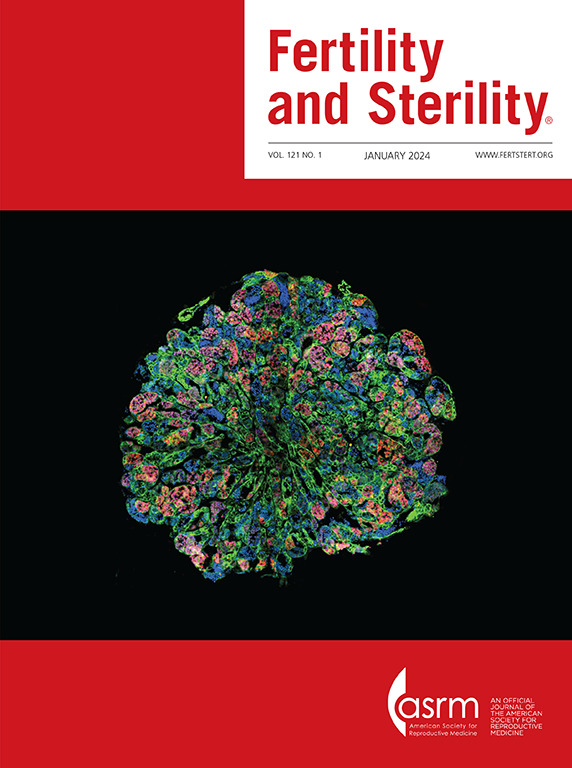Advanced maternal age was associated with an annual decline in reproductive success despite use of donor oocytes: a retrospective study
IF 7
1区 医学
Q1 OBSTETRICS & GYNECOLOGY
引用次数: 0
Abstract
Objective
To study if there is an increasing risk of poor reproductive outcomes associated with age in in vitro fertilization (IVF) patients using donor oocytes, and when it becomes clinically relevant.
Design
Multicenter, retrospective cohort study.
Subjects
IVF patients ≥35 years at 19 private fertility clinics in Spain.
Exposure
A single day 5 embryo from a donor oocyte (<35 years) was transferred to the IVF patient undergoing hormone replacement therapy, between February 2000 and September 2022.
Main Outcome Measures
Live birth, implantation failure, and pregnancy loss rates were analyzed using a continuous scale of women’s ages to determine the gradual effect of age that is clinically relevant. The relative risks (RRs) of pregnancy loss and implantation failure after 40 years of age were calculated, adjusting for body mass index, IVF cycle parameters, and the embryo’s developmental stage and euploidy.
Results
Analysis of 33,141 good-quality, single embryo transfers identified the maternal age at which reproductive rates worsened as 39, 40 and 43 years for implantation failure, live birth, and pregnancy loss rates, respectively. Before live birth rates drastically decreased, there was no significant increment in the RR for negative outcomes. Nevertheless, after the age of 40, the RR of implantation failure increased by 4.2% per year (RR = 1.042, 95% Confidence interval [CI]: 1.028–1.056) whereas that of pregnancy loss increased by 3.2% per year (RR = 1.032, 95% CI: 1.013–1.051).
Conclusion
Challenging traditional paradigms that embryo factors drive the detrimental effect of age on reproductive outcomes, this study reveals that uterine age may also play a significant role in age-related detrimental effects. Given that embryo factors were controlled for, these findings suggest that the worsening of reproductive outcomes is associated with the effects of age in the uterus. In addition, this study design identified the specific age at which the live birth rate decreases, and the implantation failure rate and pregnancy loss rate increase. Our results encourage further study of how uterine age annually impacts pregnancy rates and support the uterus becoming a potential target for antiaging therapies aiming to improve outcomes of assisted reproductive technologies.
La edad materna avanzada se asoció con una disminución anual en el éxito reproductivo a pesar del uso de ovocitos donados: un estudio retrospectivo
Objetivo
Estudiar si existe un riesgo aumentado de resultados reproductivos desfavorables asociados con la edad en pacientes de fertilización in vitro (FIV) que utilizan ovocitos donados, y cuándo este riesgo se vuelve clínicamente relevante.
Diseño
Estudio de cohorte retrospectivo multicéntrico.
Poblacion
Pacientes de FIV mayor o igual a 35 años, de 19 clínicas privadas de fertilidad en España.
Intervencion
Se transfirió un único embrión de día 5, proveniente de un ovocito de donante (menor o igual a 35 años), a la paciente de FIV que estaba bajo terapia de reemplazo hormonal, entre febrero de 2000 y septiembre de 2022.
Medidas de resultado principales
Se analizaron tasas de nacidos vivos, falla de implantación y pérdida de embarazo utilizando una escala continua de edad de las mujeres para determinar si el efecto gradual de la edad es clínicamente relevante. Se calcularon los riesgos relativos (RR) de pérdida del embarazo y falla de implantación después de los 40 años, ajustando por índice de masa corporal, parámetros del ciclo de FIV, estadio de desarrollo y euploidía embrionaria.
Resultados
El análisis de 33.141 transferencias de embriones unicos de buena calidad identificó las edades maternas en las que las tasas reproductivas empeoraron: 39 años para falla de implantación, 40 años para la tasa de nacido vivo, y 43 años para la tasa de pérdida de embarazo. Antes de que las tasas de nacido vivo disminuyeran drásticamente, no hubo un incremento significativo en el RR de resultados negativos. Sin embargo, después de los 40 años, el RR de falla de implantación aumentó un 4,2% por año (RR = 1.042, intervalo de confianza [IC] del 95%: 1.028–1.056), mientras que el RR de pérdida de embarazo aumentó un 3,2% por año (RR = 1.032, IC del 95%: 1.013–1.051).
Conclusión
Desafiando los paradigmas tradicionales que atribuyen los efectos negativos de la edad a factores embrionarios en los resultados reproductivos, este estudio revela que la edad uterina también puede desempeñar un papel significativo en los efectos perjudiciales relacionados con la edad. Dado que los factores embrionarios fueron controlados, estos hallazgos sugieren que el empeoramiento de los resultados reproductivos está asociado con los efectos de la edad en el útero. Además, el diseño del estudio identifico la edad específica en la que disminuye la tasa de nacidos vivos y aumentan las tasas de falla de implantación y pérdida de embarazo. Nuestros resultados fomentan futuros estudios sobre cómo la edad uterina impacta anualmente las tasas de embarazo y respaldan que el útero se convierta en un objetivo potencial para terapias antienvejecimiento destinadas a mejorar los resultados de las tecnologías de reproducción asistida.
尽管使用了供体卵母细胞,高龄产妇仍与每年生殖成功率下降有关:一项回顾性研究。
目的研究在使用供体卵母细胞的体外受精患者中,不良生殖结局的风险是否与年龄相关,以及何时与临床相关。设计:多中心、回顾性队列研究:西班牙19家私人生育诊所≥35岁的IVF患者。从供体卵母细胞获得的单个5天胚胎(0.05)。然而,40岁以后,植入失败的相对风险每年增加4.2% (RR = 1.042, 95% CI: 1.028-1.056;p值<0.0001),而流产率每年增加3.2% (RR = 1.032, 95% CI: 1.013-1.051;p值= 0.0007)。结论挑战了胚胎因素驱动年龄对生殖结果不利影响的传统范式,本研究揭示了子宫年龄可能在年龄相关的不利影响中也起着重要作用。考虑到胚胎因素被控制,这些发现表明生殖结果的恶化与子宫年龄的影响有关。此外,本研究设计确定了活产率下降、着床失败率和流产率增加的具体年龄。我们的研究结果鼓励进一步研究子宫年龄对妊娠率的影响,并支持子宫成为旨在改善辅助生殖技术结果的抗衰老治疗的潜在靶点。
本文章由计算机程序翻译,如有差异,请以英文原文为准。
求助全文
约1分钟内获得全文
求助全文
来源期刊

Fertility and sterility
医学-妇产科学
CiteScore
11.30
自引率
6.00%
发文量
1446
审稿时长
31 days
期刊介绍:
Fertility and Sterility® is an international journal for obstetricians, gynecologists, reproductive endocrinologists, urologists, basic scientists and others who treat and investigate problems of infertility and human reproductive disorders. The journal publishes juried original scientific articles in clinical and laboratory research relevant to reproductive endocrinology, urology, andrology, physiology, immunology, genetics, contraception, and menopause. Fertility and Sterility® encourages and supports meaningful basic and clinical research, and facilitates and promotes excellence in professional education, in the field of reproductive medicine.
 求助内容:
求助内容: 应助结果提醒方式:
应助结果提醒方式:


